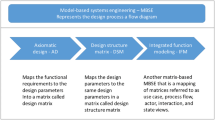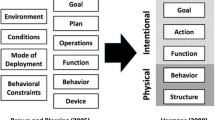Abstract
The three most important phases of design are (1) conceptual phase; (2) configuration phase; and (3) parameterization phase. The second and the third phases are well researched. However, little work has been done in the conceptual design phase. In this paper the author deals with a different way of modeling the conceptual design phase. In this research the paradigm of function-to-structure transformation is used. One of the most difficult ideas of design is that of modeling the function-to-structure transformation process. The current research shows that the function-to-structure transformation is accomplished through a process of association. Whenever a designer is faced with finding a solution to a new functional requirement, the designer tries to associate this new function with known functions from his/her memory through a process of association. After having identified the closest function, an associated structure can be retrieved and mutated to form the design solution for the new problem. In essence, the designer associates the new functions with known functions and will try to retrieve the closest and most general design solution from his/her memory through a process of association. The author models the human associative memory through artificial neural networks (ANN) with back-propagation. A simple yet illustrative example of cups and containers is selected to model the function-to-structure transformation process at the conceptual design phase. In this paper the implementation aspects of the ANN are clearly explained. The robustness of the ANN through different schemes is also explored. A performance analysisvia simulation by varying the nodes of the hidden layer is also carried out.
Similar content being viewed by others
References
Dixon, J. R. (1988) On research methodology towards a scientific theory of engineering design.AI EDAM,1, 3.
Finger, S. and Dixon, J. (1989a) A review of research in mechanical engineering design. Part I: descriptive, prescriptive, and computer-based models of design processes.Research in Engineering Design,1, 57–61.
Finger, S. and Dixon, J. (1989b) A review of research in mechanical engineering design. Part II: representations, analysis, and design for the life cycle.Research in Engineering Design,1, 121–37.
Freeman, P. and Newell, A. (1971) A model for functional reasoning in design, inProceedings of the 2nd IJCAI. London, pp. 621–40.
Gant, D. E. (1987) New tools for product design optimization, inProceedings of ICED 87.
Kamarthi, V., Kumara, S. R. T., Franscis, Y. and Ham, I. (1990) Applications of neural networks in component design data retrieva.Journal of Intelligent Manufacturing,1, 125–40.
Kumara, S. R. T. and Ham, I. (1990) Use of associative memory in conceptual design.Annals of CIRP, Vol 39, 117–20.
Lobov, W. (1973) The Boundaries of Words and their Meanings, inNew ways of Analyzing Variations in English, Vol. 1, Bailey, C.-J. N. and Shuy, R. W. (eds), Georgetown University Press. Washington, pp. 340–73.
McClelland, J. L., Cleeremans, A. and Servan-Schreiber, D. (1989) Parallel distributed processing: bridging the gap between human and machine intelligence, inProceedings of the Third Conference of Japanese Society for Artificial Intelligence.
Merchawi, N. S., Kumara, S. R. T. and Thazhathuveetil, M., (1991) Neural networks in continuous process diagnostics.Pattern Recognition and AI, submitted.
Minsky, L. M. and Papert, S. A. (1988)Perceptrons: An introduction to computational geometry, MIT Press, Cambridge, MA.
Mostow, J. (1985) Toward better models of the design process.AI Magazine,Spring, 44–57.
Rosenblatt, F. (1962)Principles of Neurodynamics: Perceptrons and the Theory of Brain Mechanisms, Spartan Books, New York.
Rumelhart, D. E., Hinton, G. E. and Williams, R. J. (1986)Parallel distributed processing: explorations in the microstructure of cognition, Vol. 1: MIT Press, Cambridge, MA.
Rzevski, G. (1980) On the design of a design methodology. Design: science: method, inProceedings of the 1980 Design Research Society Conference, Jacques, R. and Powell, J. A. (eds).
Simon, H. A. (1969),Sciences of the Artificial (1st edn), MIT Press, Cambridge, MA.
Suh, N. P. (1988) Basic concepts in design for producibility.Annals of the CIRP,37, 1–9.
Suh, N. P. (1990)The Principles of Design, Oxford University Press, UK.
Werbos, P. J. (1974) Beyond regression: new tools for prediction and analysis in the behavioral sciences, Master's thesis, Harvard University.
Yoshikawa, H. (1983a) Automation of thinking in design, inComputer applications in production and engineering, Warman, E. A. (ed.), IFIP, pp. 405–17.
Yoshikawa, H. (1983b) CAD framework guided by general design theory, inCAD Systems Framework, Bo, K. and Lillehagen, F. M. (eds), IFIP, pp. 241–53.
Author information
Authors and Affiliations
Rights and permissions
About this article
Cite this article
Kumara, S.R.T., Kamarthi, S.V. Function-to-structure transformation in conceptual design: An associative memory-based paradigm. J Intell Manuf 2, 281–292 (1991). https://doi.org/10.1007/BF01471176
Received:
Accepted:
Issue Date:
DOI: https://doi.org/10.1007/BF01471176




